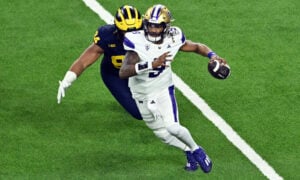Tracking the 2017 Rookie Running Back Class: Tarik Cohen
This article is one installment of a series in which I use my Observational Rushing Numbers to shed light on just how good the 2017 rookie running backs were at carrying the ball. You can find each previous article about these numbers on the series’s hub, including similar articles about Leonard Fournette and Joe Mixon.
Coming out of an FCS program at North Carolina A&T, Tarik Cohen was no household name. But, those who had heard of him knew he deserved plenty of attention. As he produced highlight after highlight for the Aggies, some internet draft scouts developed crushes on Cohen as a late-round playmaker. I was one member of that crowd.
Tarik Cohen is the Reggie Bush of FCS football
— Stephen Gill (@stephengill_ts) February 18, 2017
But, to my and plenty others’ surprise, the Bears called those takes on the 5’6” back and raised them a fourth-round pick in the 2017 Draft — where Cohen was taken among the likes of Samaje Perine, Joe Williams, and Marlon Mack. While I liked his potential to pull off the occasional dazzling return or reception heading into draft weekend, I strongly doubted Cohen’s ability to produce with a workload, in comparison to his fellow fourth rounders. I was wrong.
Despite competing with Jordan Howard for touches, Cohen produced over 700 yards and three touchdowns on 140 touches from scrimmage — in addition to touchdowns via punt return and pass (like, he threw the ball, yeah). For all I’ve seen, most of Cohen’s positive press has focused on his aptitude in the receiving game. To be fair, he is a tantalizing open-field threat and deft pass-catcher and thus deserves that praise. But, it appears that his running game might be flying way too far under the radar. After all, he ran for 4.3 yards per carry in his rookie season, a respectable number for anyone — better than Howard, even.
In this article, I’ll be looking into whether Cohen is a legitimate rushing talent and to what degree he contributed to those positive rushing numbers (independently of the offensive line) in consultation with my Observational Rushing Numbers.
(I’ve taken these tracking stats from weeks 1-14 for each rookie running back with at least 75 carries. If you’re wondering what any of the stats mean in a fuller sense, check the series glossary.)
[am4show have=’g1;’ guest_error=’sub_message’ user_error=’sub_message’ ]
At a glance
Four Big Stats and Class Radar


The top half of that chart is entirely unsurprising. You’d expect Cohen, given his 5’6” stature, to offer little-to-nothing without room to work (measured by SGY/C). You’d expect him, given his ridiculous college highlight tape, to be pretty great with room to work (measured by HGY/C).
On the other hand, what wasn’t necessarily quite as expected was his second-in-class Success Rate (which measures how well he hit holes). That finish was enough to push him to sixth in the class in RB Composite (an overall measure of how well a back contributes to the running game), ahead of players like Leonard Fournette, Joe Mixon, and Christian McCaffrey. He wasn’t the best back in a crowd of bodies (nor will he ever be), but in aggregate, he was an above-average back by making up for it in the other two areas.
Success Rate
It’s no mystery why Cohen’s Success Rate was so good. By hitting a perfect 30 holes out of 30, he’s the only back of the 34 total 2017 rushers I’ve tracked (thus far) to attain a 100% Hit Rate (which measures how well a back gets to and through the holes he’s found). At 93.8%, his Identification Rate (which measures how well a back finds holes) was perfectly fine as well.

Hit Generated Yards
Cohen’s Success Rate is great, but his open-field play (and, perhaps, his size in a different way) is what sets him apart from the typical back. And with the class’s third-best HGY/C mark, he lived up to his potential in 2017. As for the future, it’s a bit of a bad news/good news situation.
The bad? While he put up great numbers last season, we wouldn’t necessarily expect him to do so again in 2018. For any back, their Gash Rate (how often they generated at least ten yards when hitting a hole) and Broken Tackles per Hit (BTK/Hit, how often they broke a tackle when hitting a hole) are good indicators of how legitimate their open-space production was. In Cohen’s case, both stats would indicate that his HGY/C would be much closer to average than it actually was in 2017:


The good news is that while we’d expect his HGY/C to fall a decent bit in 2018, it should still be pretty good — well above average, even. Such a fall would only knock him back to around average among all RBs (veterans included). Pretty good for a 66-incher.
Stuff Generated Yards
Just as we’d expect Cohen’s HGY to trend closer to average in the future, we would also expect his SGY to approach average in 2018 and beyond. His Chunk Rate (how often he generated at least three yards on carries where the offensive line didn’t open a hole), which can be seen as the limited-space equivalent to Gash Rate, indicates that his SGY/C should be closer to 0.70 (as opposed to 0.52) in the future:

That would constitute a jump of ten spots — from 33rd (out of 34) to 23rd. Such a rise could roughly cancel out his projected open-field regression, and keep him at the same overall (in terms of RB Composite) level.
Of course, you might be wondering how any film-based metric could project anyone who’s 5’6” to not be anything but terrible at rushing in a crowd. But, as I discussed in Christian McCaffrey’s tracking article, there’s much more to contributing in this area than size. Anyone can be a net-neutral by (a) turning upfield as quickly as possible when no opportunity presents itself and (b) using strong technique and running attitude to lower their pads and drive their feet through contact. It also doesn’t hurt to be quick. Cohen checks that last box, and has also done each of the other two things fairly well. He’ll never be great at running without space, but some important signs suggest he should be passable.
Run blocking
Three Big Stats

Generally, I’ll make stronger claims when discussing offensive lines, but for the Bears, I’m working with a limited data set. This is because I haven’t yet tracked Jordan Howard’s 2017 performance (and because the Bears have the worst All-22 camera in the NFL, he isn’t at the top of my watch list either), so I only have 88 Cohen carries to work from.
Nonetheless, I feel comfortable saying 2017 was a disappointing season for this unit. After finishing eighth in Football Outsiders’ Adjusted Line Yards in 2016, the Bears fell to 28th in Adjusted Line Yards and put forth a well below average OL Composite (my measure for overall run blocking quality) in 2017.
While the unit provided Cohen with a fair amount of open-field opportunities (measured by Hole Rate), it allowed far too much penetration. He had to dodge tacklers in the backfield almost twice as often as the average back (28% of the time vs 16%)… he had to dodge tacklers four yards into the backfield three and a half times as often (5.9% vs 1.7%).
Generally, you can blame a weak link or two for such high levels of penetration, and perhaps you can here, too. If I had to guess, I’d point my finger at some combination of Tom Compton, Bradley Sowell, and Hroniss Grasu. All three were backups heading into the season and stepped in primarily when Kyle Long and Josh Sitton went down.
Unfortunately, Sitton is now a Miami Dolphin, which means either one of those three or second rounder James Daniels will have to figure it out. Perhaps better health for Long (who played just 45% of the team’s offensive snaps in 2017) could help out, but even then, the rest of the unit will probably get hurt more — Charles Leno, Cody Whitehair, and Bobby Massie all logged at least 92% of their snaps, which is about as healthy as it gets.
Which leads me to a common refrain: Health is probably the number one retroactive indicator of success for 31 of 32 offensive lines (success isn’t an actual possibility for a Seattle offensive line), and the case is the same here. So, again, almost everything rides on how well the unit stays in games. Still, in Chicago’s case, a lot rests on replacing Sitton too.
Conclusion
Tarik Cohen has drawn most of his NFL acclaim in the passing game, but I’d argue that he’s just as good at toting the rock. He has solid vision, legitimately terrific quickness, agility, and balance, and can make all kinds of things happen in space. He’s small, which will always lower his ceiling in tight spaces, but there are reasons to think he can get by — a big deal when he offers such upside when there’s more room to run. Altogether, that adds up to above-average rushing productivity, veterans included.
It’ll be interesting to see how those numbers develop, given his individual signals of change (through the discrepancy between his generated yard rates and averages) and the surrounding changes that are sure to take place (through coaching and personnel). Although there are many variables yet to play out, at the end of the day, I’d feel confident in betting on Cohen’s talent.
[/am4show]
- Devy Fantasy Football: Top Five Quarterbacks - August 22, 2022
- 2022 Dynasty Fantasy Football Rookie Prospect: Drake London, WR USC - April 16, 2022
- 2021 NFL Draft Prospect: Elijah Moore, WR Ole Miss - April 2, 2021


































































